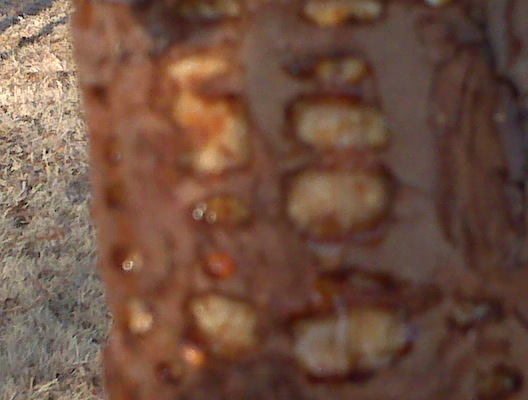Question
 Loblolly pine issue
Loblolly pine issue
Hi...these loblolly pines were planted in November of 2009. Just recently we have noticed these patches of holes that remind me of a honeycomb and sap drops come out of it. Could you please advise us on how to fix the problem. Am curious to know if its a fungus or some kind of a bug. Thank you for your help
AnswerThe picture is a bit fuzzy, but it is likely that the problem is caused by damage from a woodpecker such as a yellow-bellied sapsucker. Sometimes, woodpecker damage resembles wood-boring beetle emergence holes, but beetles generally have a more random pattern. Woodpeckers (also called sapsuckers) tend to produce holes in lines.
Sapsuckers feed on many types of trees, ornamental, landscape and fruit. They drill a series of holes in either horizontal or vertical rows in tree trunks or large limbs. Because they sit vertically on the trunk or along the long axis of the limb, these holes are located between branches. As sap flows into the holes, the sapsucker uses its brushlike tongue to draw the sap up along with any insects that are attracted to the sap. The birds will also periodically enlarge the holes and eat portions of the cambium, inner bark, and fresh sap. In some cases, they can feed heavily enough on trees to kill them.
Woodpeckers are classified under the Migratory Bird Treaty Act as migratory insectivorous birds and are protected by both state and federal law. As a result, certain activities affecting them are subject to legal restriction. It is illegal for any person to kill, take, possess, transport, sell, or purchase them or their parts, such as feathers, nest, or eggs without a permit issued by the U.S. Fish and Wildlife Service. However, a state or federal permit is not required to scare or harass a woodpecker that is causing damage.
Prompt and persistent action is required to deter a woodpecker that is attracted to a particular tree or area. The use of a combination of scaring techniques is more successful than relying on just one scaring technique or device. Strips of aluminum foil 3 to 4 inches wide and 3 to 4 feet long or similar-sized strips of cloth or plastic can be hung in front of the damaged area. Tin can lids or aluminum pie pans tied to heavy string so they will rattle and flash in the sun can also be used. Raptor silhouettes or effigies have been successfully used in some cases. Repellents such as Tanglefoot, Bird Stop, and Roost-No-More can be applied to tree limbs and trunks to discourage sapsuckers. Or the repellents can first be applied to a thin piece of pressed board, ridged clear plastic sheets, or other suitable material, which is then fastened to the areas where damage is occur-ring. Loosely wrapping sapsucker-damaged limbs in burlap, hardware cloth, or plastic will protect the area from further damage. Be sure to remove this wrapping after the birds have migrated through the area and before the weather becomes consistently warm. Treating the damaged areas with asphalt-based roofing paint has successfully repelled sapsuckers that were damaging fruit trees.
Answered by myself and my colleague, Rick Grantham






